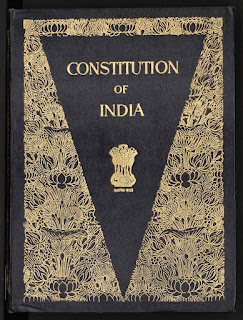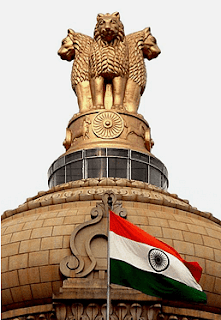Indian Constitution
Indian Constitution
Hello my friends,
This is my
first blog and I think you will feel good and happy after reading this article.
Today we
will discuss about Our Constitution- “
THE INDIAN CONSTITUTION “
Friends in
2020 we will almost celebrate our 75th anniversary of freedom. And
the 70th anniversary of Democracy. The main and the best of our
India is our Constitution. Which gives us freedom of doing everything.
Indian
Constitution is world’s Largest written Constitution.
So, here we
saw the salient features of Indian Constitution, so friends here it is-
The Constitution
of India is the supreme law in India.
A Constitution is
a set of rules and regulations guiding the administration of a country. The
constitution of India is the framework for political principles, procedures and
powers of the government. It is also the longest constitution in the world with
395 articles and 12 schedules. Originally it consisted of 395 Articles arranged
under 22 Parts and 8 Schedules. Today after many amendments, it has 448 Article
and 12 schedules and 25 parts ( According to 2019). The constitution was
written on 26 November 1949, and was made the center of law in 26 January 1950.
India had to face many
problems after independence.
Rehabilitating the refugees who migrated from Pakistan,
merging the princely states,
maintenance of law and order were the major challenges. Sardar Patel
successfully achieved the merger of the princely states and
provinces with the Union of India.
Even the challenge of framing a constitution in order to enable govern the
country was also fulfilled.
The recommendations of
the Motilal Nehru Committee and the decisions taken by the meeting of National
Congress at Karachi prepared
for the formation of a Constituent Assembly.
The first meeting of the
new Constituent Assembly was conducted on 9th of December, 1946. The next
meeting conducted in 11th of December, 1946 under the chairmanship of Dr.
Rajendra Prasad. Participants included Jawaharlal Nehru,
Sardar Vallabhai Patel, Dr.B.R.Ambedkar(Dr. Bhim Rao Ambekar)and Sarojini
Naidu. Dr. B.R Ambedkar, chairman of the Drafting Committee, is often called
the father of the Indian Constitution.
The 389 members of the
Constituent Assembly formed many committees to examine in detail all the issues
relating to the country. Dr.B.R.Ambedkar was the Chairman of one of the most
important committees, i.e., the Drafting Committee. Other members of the
committee were N.Gopalaswamy Iyengar, Alladi Krishnaswamy etc.
The Constituent Assembly,
which came into existence on 11th of December 1946, had 145 meetings and framed
a draft constitution. During these discussions, the various laws proposed by
the British Government in 1909, 1919 and 1935, the British Parliamentary system, the American Bill of Rights, the Social Directive
Policies of Ireland were studied and some parts of those were written in the
Constitution. Finally, the Indian Constitution was approved on 26th of
November, 1949 and came into effect on 26th of January, 1950. This day (January
26) is celebrated as the 'Republic Day' in India.
The Republicof India is divided into
twenty-eight States, and eight union territories including the National Capital Territory.
States of India
SN. No.
|
States
|
Capitals
|
Code
|
1
|
Amaravati
|
AP
|
|
2
|
Itanagar
|
AR
|
|
3
|
Dispur
|
AS
|
|
4
|
Patna
|
BR
|
|
5
|
Raipur
|
CT
|
|
6
|
Panaji
|
GA
|
|
7
|
Gandhi nagar
|
GJ
|
|
8
|
Chandigarh
|
HR
|
|
9
|
Shimla
|
HP
|
|
10
|
Ranchi
|
JH
|
|
11
|
Bengaluru
|
KA
|
|
12
|
Thiruvananthapuram
|
KL
|
|
13
|
Bhopal
|
MP
|
|
14
|
Mumbai
|
MH
|
|
15
|
Imphal
|
MN
|
|
16
|
Shillong
|
ML
|
|
17
|
Aizawl
|
MZ
|
|
18
|
Kohima
|
NL
|
|
19
|
Bhubaneswar
|
OD
|
|
20
|
Chandigarh
|
PB
|
|
21
|
Jaipur
|
RJ
|
|
22
|
Gangtok
|
SK
|
|
23
|
Chennai
|
TN
|
|
24
|
Hyderabad
|
TS
|
|
25
|
Agartala
|
TR
|
|
26
|
Lucknow
|
UP
|
|
27
|
Dehra Dun
|
UA/UK
|
|
28
|
Kolkata
|
WB
|
Union territories:
Region
indicated in the map
|
Union territory
|
Capital
|
A
|
Port
Blair
|
|
B
|
Chandigarh
|
|
C
|
Daman
|
|
D
|
Srinagar
|
|
E
|
Leh
|
|
G
|
New
Delhi
|
|
F
|
Kavaratti
|
|
H
and I
|
Puducherry
|
India, also known as Bharat, is a Union of States. It is a
Sovereign Socialist Secular Democratic Republic with a parliamentary system of
government. The Republic is governed in terms of the Constitution of India
which was adopted by the Constituent Assembly on 26th November, 1949 and came
into force on 26th January, 1950. The Constitution provides for a Parliamentary
form of government which is federal in structure with certain unitary features.
The constitutional head of the Executive of the Union is the President. As per
Article 79 of the Constitution of India, the council of the Parliament of the
Union consists of the President and two Houses known as the Council of States
(Rajya Sabha) and the House of the People (Lok Sabha). Article 74(1) of the
Constitution provides that there shall be a Council of Ministers with the Prime
Minister as its head to aid and advise the President, who shall exercise
his/her functions in accordance to the advice. The real executive power is thus
vested in the Council of Ministers with the Prime Minister as its head.
Indian Constitution frames fundamental political principles,
procedures, practices, rights, powers, and duties of the government. It
imparts constitutional supremacy and not parliamentary supremacy, as it is not
created by the Parliament but, by a constituent assembly, and adopted by its
people, with a declaration in its preamble. Parliament cannot override it.
As we discuss above that The constitution of India was adopted on the
26th of November, in the year 1949. However, it came to effect on the 26th of
January, 1950. 26th of January is celebrated as the Republic Day of India.
It was adopted by the Constitution Assembly. Dr. B. R.
Ambedkar, the chairman of the Drafting Committee, is widely
considered to be the architect of the Constitution of India. After, the
adoption of the constitution, The Union of India became the contemporary and
modern Republic of India.
India is the largest democracy of the world. And our constitution plays
a big role in our life it gives us the rights to live our life with full of
dignity and respectfully.
So friends this is all for today. In my next blog you will find the
best features of Our Constitution. And till than be happy, make your family
happy, and respect our elders, respect our Indian armed forces, respect Our
“Tiranga”, respect Indian society and Respect our Great Nation India.
JAI HIND JAI BHARAT.











" A blogs about MPSC Exams Hub and current affairs" Current Affairs Global as well as in India, Civics, History of Modern India especially Maharashtra
ReplyDeleteI read this post your post so nice and very informative post thanks for sharing this post
ReplyDeleteStock Broker, Online Trading Firms, share brokerage firms , share market brokers in Indore ,securities brokerage firm, share market brokers , securities brokerage , stock brokerage firms , share trading companies , brokerage firm , stock brokers , broker company , share broking company , brokerage firm , securities broker , online trading broker , online stock broker , share market brokers list in India , stock brokers online , share market brokers in India, share market brokers India , stock broker firms in India , best brokerage firms , trading account
For Free Certificate and educational guidance visit
ReplyDeleteFRee Books ALSo Available
Nice article, thanks for sharing about Indian constitution
ReplyDeleteIf you want to learn more about Indian Constitution pls visit-
indianconstitutions.com
thanks sir for this useful knowledge.
ReplyDeleteto know about more articles plz visit-https://class12poiticalscience.blogspot.com/2020/07/important-questions-chapter-1.html
This is awesome blog I found the information very helpful among many blogs out there.
ReplyDeleteA magnificent plant-based workout partner infused with 100% natural CBD. It tastes delicious, builds muscle and supports recovery. Hemp Protein is a great protein source for vegetarians and vegans due to its complete amino acid profile.
read more
a set of questions on general knowledge as well as Marathi grammar, arithmetic, and intelligence https://policebharati2020.blogspot.com/
ReplyDeleteNice article, thanks for sharing about Indian constitution
ReplyDeleteIf you want to know about daily govt job notification pls visit-
www.dreampost.in
Nice to read your article! I am looking forward to sharing your adventures and experiences.
ReplyDeleteCompare Brokers UK